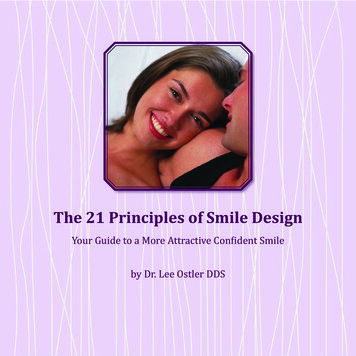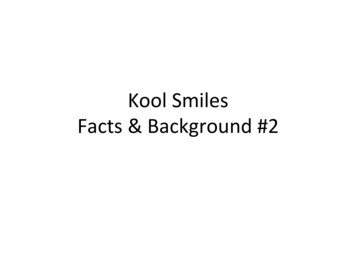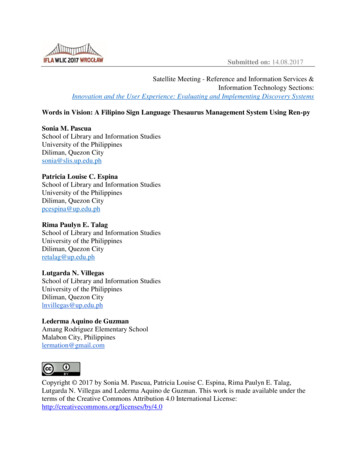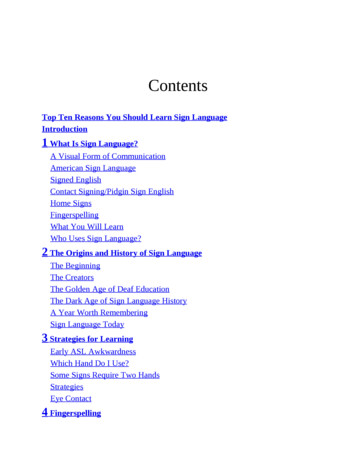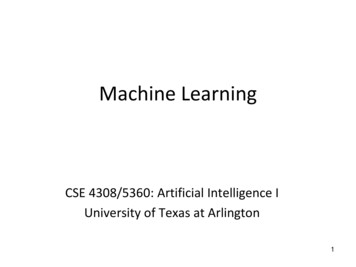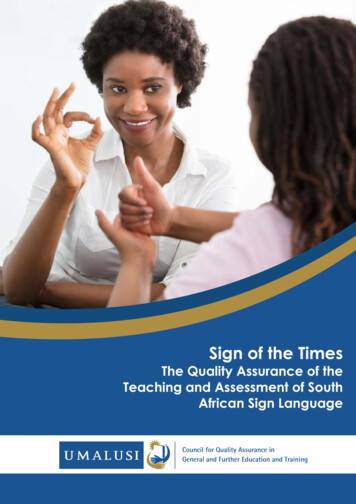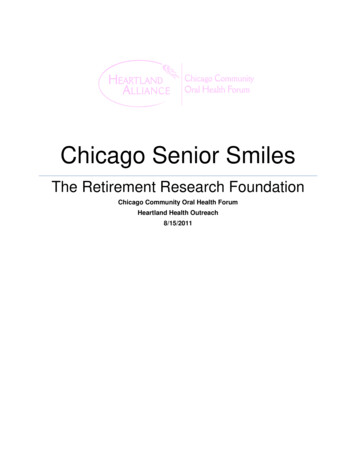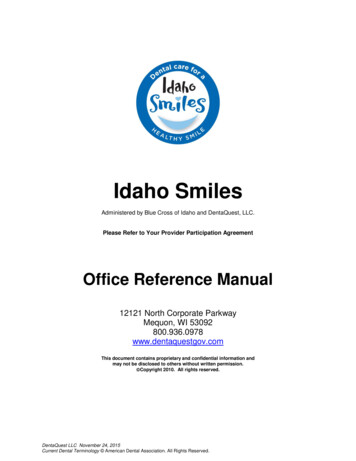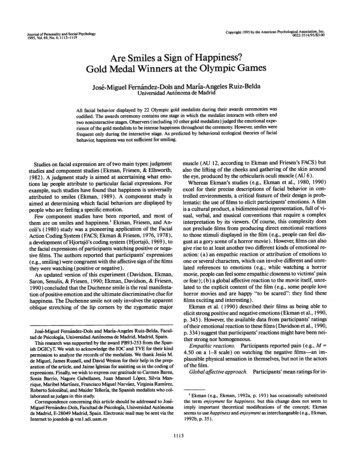
Transcription
Copyright 1995 by the American Psychological Association, Inc.Journal of Personality and Social Psychology1995, Vol. 69, No. 6,1113-1119Are Smiles a Sign of Happiness?Gold Medal Winners at the Olympic GamesJose-Miguel Fernandez-Dols and Maria-Angeles Ruiz-BeldaUniversidad Autonoma de MadridAll facial behavior displayed by 22 Olympic gold medalists during their awards ceremonies wascodified. The awards ceremony contains one stage in which the medalist interacts with others andtwo noninteractive stages. Observers (including 10 other gold medalists) judged the emotional experience of the gold medalists to be intense happiness throughout the ceremony. However, smiles werefrequent only during the interactive stage. As predicted by behavioral ecological theories of facialbehavior, happiness was not sufficient for smiling.Studies on facial expression are of two main types: judgmentstudies and component studies (Ekman, Friesen, & Ellsworth,1982). A judgment study is aimed at ascertaining what emotions lay people attribute to particular facial expressions. Forexample, such studies have found that happiness is universallyattributed to smiles (Ekman, 1989). A component study isaimed at determining which facial behaviors are displayed bypeople who are feeling a specific emotion.Few component studies have been reported, and most ofthem are on smiles and happiness.1 Ekman, Friesen, and Ancoli's (1980) study was a pioneering application of the FacialAction Coding System (FACS; Ekman & Friesen, 1976,1978),a development of Hjortsjo's coding system (Hjortsjo, 1969), tothe facial expressions of participants watching positive or negative films. The authors reported that participants' expressions(e.g., smiling) were congruent with the affective sign of the filmsthey were watching (positive or negative).An updated version of this experiment (Davidson, Ekman,Saron, Senulis, & Friesen, 1990; Ekman, Davidson, & Friesen,1990) concluded that the Duchenne smile is the real manifestation of positive emotion and the ultimate discriminative clue forhappiness. The Duchenne smile not only involves the apparentoblique stretching of the lip corners by the zygomatic majorJose-Miguel Fernandez-Dols and Maria-Angeles Ruiz-Belda, Facultad de Psicologia, Universidad Autonoma de Madrid, Madrid, Spain.This research was supported by the award PB93-253 from the Spanish DGICyT. We wish to acknowledge the IOC and TVE for their kindpermission to analyze the records of the medalists. We thank Jesus M.de Miguel, James Russell, and David Weston for their help in the preparation of the article, and Jaime Iglesias for assisting us in the coding ofexpressions. Finally, we wish to express our gratitude to Carmen Barea,Sonia Barrio, Nagore Gabellanes, Juan Manuel Lopez, Silvia Manrique, Maribel Martinez, Francisco Miguel Narvaez, Virginia Ramirez,Roberto Solozabal, and Maider Telleria, the Spanish medalists who collaborated as judges in this study.Correspondence concerning this article should be addressed to JoseMiguel Fernandez-Dols, Facultad de Psicologia, Universidad Autonomade Madrid, E-28049 Madrid, Spain. Electronic mail may be sent via theInternet to josedols @ vm 1 .sdi.uam.esmuscle (AU 12, according to Ekman and Friesen's FACS) butalso the lifting of the cheeks and gathering of the skin aroundthe eye, produced by the orbicularis oculi muscle (AU 6).Whereas Ekman's studies (e.g., Ekman et al., 1980, 1990)excel for their precise descriptions of facial behavior in controlled environments, a critical feature of their design is problematic: the use offilmsto elicit participants' emotions. A filmis a cultural product, a bidimensional representation, full of visual, verbal, and musical conventions that require a complexinterpretation by its viewers. Of course, this complexity doesnot preclude films from producing direct emotional reactionsto those stimuli displayed in the film (e.g., people can feel disgust at a gory scene of a horror movie). However,filmscan alsogive rise to at least another two different kinds of emotional reaction: (a) an empathic reaction or attribution of emotions toone or several characters, which can involve different and unrelated references to emotions (e.g., while watching a horrormovie, people can feel some empathic closeness to victims' painor fear); (b) a global affective reaction to the movie itself, unrelated to the explicit content of the film (e.g., some people lovehorror movies and are happy "to be scared": they find thesefilms exciting and interesting).Ekman et al. (1990) described their films as being able toelicit strong positive and negative emotions (Ekman et al, 1990,p. 345). However, the available data from participants' ratingsof their emotional reaction to thesefilms(Davidson et al., 1990,p. 334) suggest that participants' reactions might have been neither strong nor homogeneous.Empathic reactions. Participants reported pain (e.g., M 4.50 on a 1-8 scale) on watching the negative films—an implausible physical sensation in themselves, but not in the actorsof the film.Global affective approach. Participants' mean ratings for in-1Ekman (e.g., Ekman, 1992a, p. 193) has occasionally substitutedthe term enjoyment for happiness, but this change does not seem toimply important theoretical modifications of the concept; Ekmanseems to use happiness and enjoyment as interchangeable (e.g., Ekman,1992b, p. 35).1113
1114JOSE-MIGUEL FERNANDEZ-DOLS AND MARIA-ANGELES RUIZ-BELDAterest, from 5 to 5.60, and excitement, from 2.15 to 2.73, wereas high for positive as for negative films.Weak direct emotional reactions. Participants did not report clear and intense positive or negative basic emotions: on ascale from 0 to 8, participants' highest mean ratings on the positivefilmswere 6.05 for amusement, 5.60 for interest, and only4.68 for happiness. The highest ratings on the negative filmswere for disgust (6.70), interest (5.52), pain (4.50), fear(4.45), anger(3.60), and sadness (3.30).In summary, these component studies have developed an impressive observational and physiological paraphernalia aroundthe dependent variable (facial behavior), with a surprisinglypoor method around the independent variable—the elicitor ofthose emotions hypothesized to cause the facial behavior. Thislack of clear elicitors is a seriousflawthat blurs the link betweenthe observed facial expressions and their assumed emotionalcauses, calling into question the conclusions of these studies.The Naturalistic Approach to Component StudiesKraut and Johnston's (1979) studies involved the only alternative approach to component studies in general, and to thestudy of the relationship between facial expression and happiness in particular. Kraut and Johnston performed a series offield studies on people's facial expression in natural, everydaysituations, such as bowling, cheering on their favorite sportsteam, or greeting other people in public places. The strengthsand weaknesses of Kraut and Johnston's method were the reverse of those of the film studies. Kraut and Johnston obtaineda sample of participants who were directly exposed to an emotional elicitor. No films, written texts, or any other symbolicconvention blurred the participants possible interpretation ofthe elicitor.Kraut and Johnston (1979) found that people did not smileduring the events that were presumably the cause of their happiness (e.g., bowlers' best rolls, goals for the fans' team, or goodweather). Smiles occurred during social interaction (e.g., bowlers' conversations with their friends in the pit, fans' interactions,or greetings in the street).Nevertheless, Kraut and Johnston's study was carried out in1979, when Ekman himself had not contemplated the distinction between the Duchenne smile and other kinds of smiles (seeEkman et al., 1980), and no data about these subtle features ofsmiles are available in their report.This indetermination is aggravated by the lack of any subjective report on participants' emotional experience during theevent. As Kraut and Johnston conceded (1979; p. 1551), theydid not know whether all the selected situations had the sameemotional meaning for participants, or if their meaning was asemotional as researchers assumed. Even if all their participantswere happy, a strike during bowling, sunshine, or witnessingyour team score points might not produce extremely intensehappiness.These problems pose a conundrum for the researcher: natural and highly intense emotional elicitors are not feasible in thelaboratory, for ethical and practical reasons, whereasfieldstudies have not been able to assess participants' emotional experiences. To make matters worse, recording close-ups of partici-pants' facial expressions in emotional situations is a task thatinvolves formidable practical problems even in the laboratory.Nevertheless, at least one researcher has been successful atperforming more controlled naturalistic component studies capable of providing a precise description of participants' expressions and their relationship to a particular emotion. Camrasand colleagues (see Camras, Malatesta, & Izard, 1991) recorded an infant's facial expressions in everyday settings; theinfant's facial behavior was analyzed by Izard's AFFEX codingsystem (Izard, Dougherty, & Hembree, 1983). Camras et al.found that hypothesized expressions of particular negativeemotions ocurred in situations that were unlikely to have elicited those emotions. For example, "fear" expressions were observed in circumstances not related to fear, and the "sadness"expression was associated with low-intensity distress or anger(Camras et al., 1991). Camras also performed a judgmentstudy that supported the accuracy of these findings (Camras,Sullivan, & Michel, 1993).Camras et al.'s (1991) fascinating and unexpected resultssuggest that researchers on emotional expression should perform more studies in the frame of this new naturalistic approach to component studies that includes a precise descriptionof participants' expressions. The present study was developed,with this goal in mind, as a field study on adults' "happiness"expressions.Study 1A recent event in Spain, the Olympic Games, allowed us toperform a study on some athletes' facial expressions at one ofthe happiest times of their lives: the awarding of gold medals.Even though the Olympic Games were profusely emotional,most of the situations involved people performing tough physical exercise, which frequently distorted facial expressions. Onthe podium, winners were at rest, but the situation was as emotional as any other at the games.MethodThree social conditions. The awards ceremony involved a strikinglyprecise and uniform routine, which allowed us to compare medalistsfrom different sports in a similar context. This routine included threewell-delimited stages that constituted a natural ABA baseline design:(A) waiting behind the podium while the authorities arrived at theirpositions, with medalists' attention focused on the impending invitationthrough the loudspeakers to go to their positions on the podium; (B)standing on the podium, interacting with authorities and public, and(C) returning to the noninteractive situation, when the medal winnersturned toward theflagpolesand focused their attention on theflagsandthe national anthem.Situations A and C involved powerful restrictions of participants' social interaction. In fact, several aspects of the ceremony reinforced thisnatural manipulation, placing the medalists literally hidden behind thepodium in Stage A, and keeping the audience in silence and the medalists turned toward theflagon the top of the podium during Stage C.The goal of this study was to test the hypothesis that is inferred fromKraut and Johnston's (1979) findings that happiness alone is notsufficient to produce smiles. Rather, happiness produces smiles onlyduring social interaction. The above-described succession of interactiveand noninteractive situations allowed us to test this hypothesis with a
SMILES AND HAPPINESSprecise description of participants' facial behavior and an explicit control of their emotional experience, which was—according to gold medalists' and lay participants' judgments—of intense happiness throughout all three stages of the ceremony.Participants. Television Espafiola (TVE, the Spanish nationalbroadcasting company) provided us with all the records of awards ceremonies available from its commercial services. Availability of recordswas determined by the popularity of a particular speciality (e.g., running or gymnastics were more strongly represented than weightlifting orfencing), the presence of Spaniards on the podium (not necessarily asgold medalists), and broadcasting times. Availability of TVE's recordswas in no way determined by the facial expressions of the medalists.Only gold medalists were considered, in order to avoid frustrated goldmedal aspirants among the silver and bronze medalists.In total, we obtained 47 records. After reviewing Spanish newspapersfrom July through August 1992, we discarded two gold medalists whoseceremonies took place in peculiar circumstances, one because of political events in her country and the other because of public opposition tohis award; three cases that involved sharing the gold; and 20 cases thatdid not include one or more suitable records of the three ceremonialstages above described.Finally, 22 participants were selected (14 women and 8 men) fromChina, former Czechoslovakia, Germany, Greece, Russia, Spain, Switzerland, Tajikistan, Ukraine, the United Kingdom, and the UnitedStates of America. This relative cultural variability is an uncommon butdesirable feature in this kind of study, insofar as it partially decreases therisk of uniform cultural biases in participants' expressions.2Check on emotional experience. Even though winning a gold medalis obviously one of the happiest times in any sportsman or sportswoman's life, we needed to confirm the emotional meaning of this situation.The actual recorded medalists were unavailable, but we contacted thebest available judges to test this assumption: a group of Spanish goldmedalists, who rated the emotional content of the three stages of theceremony.These gold medalists were 7 women and 3 men (members of the women's field hockey team and of the men's soccer team). Their task consisted of rating their emotional experience atfivedifferent crucial moments from the final match (e.g., the home-team goals) and the threeabove-described stages of the awards ceremony. Situations were presented at random in a booklet, each on a different page that included abrief allusion to the situation to be judged (e.g., "Spain's second goal","the waiting time before going up to the podium" etc.). The experimenters did not mention the main topic of the study and, in fact, theextra five situations from the match were designed to avoid demandeffects.The gold medalists rated each situation on 6 scales from 0 to 10(happiness, sadness, anger, fear, disgust, and surprise); there was also ablank scale where they could mention and rate any other relevant termof their choice. We were particularly careful about avoiding unsurejudgments of any of the three situations: medalists were all invited toindicate if they were not completely sure about having clear and differentiated memories of their feelings at these specific times. Three medalists (two women and one man) suggested problems in rememberingtheir feelings about some of the three stages of the ceremony, and sotheir data were not included in the results.Table 1 shows the remaining 7 medalists' mean ratings for the threestages of the awards ceremony. Mean ratings for happiness were alwayshigher than 9, and no other emotion obtained ratings above 2, whichsuggests that these situations were judged as being of clear and intensehappiness.3Scoring of facial behavior. All the observable facial actions displayedby each participant during the three stages of the ceremony were measured by the FACS (Ekman & Friesen, 1976, 1978). This system distin-1115guishes different facial movements through different action units andallows the observer to codify Duchenne smiles—the expression that,according to Ekman (1992b; see also Ekman et al., 1990), is characteristic of felt happiness. Moreover, other different facial actions werescored, as well as other smiles that were not Duchenne smiles.The coder (the second author of this article) had specific training inFACS, and her reliability had been checked previously by a standard testdesigned by Ekman and Friesen. In order to retest the coder's reliabilityand accuracy, another coder, unaware of our hypotheses—and whosereliability had also been checked by Ekman and Friesen's standardtest—coded a random sample of those available sequences in which itwas impossible to infer the particular circumstances of the recordedexpressions. Ten sequences out of all the suitable records were randomlyselected from each stage and then randomly combined in a series of 30sequences of comparable duration (each sequence lasted a maximumof 3 s and a minimum of 1 s; if the original selected sequence was longerthan 3 s, only 3 consecutive seconds of it were randomly selected). Interrater agreement according to Ekman and Friesen criterion—agreements divided by the total number of agreements and disagreements (Ekman & Friesen, 1978)—was .80 across all the FACScategories. In terms of the four categories of facial behaviors discussedin this study, Ekman and Friesen's interrater agreement was .87, andCohen's kappa was .82 (z 8.37; p .001).ResultsThe observed behaviors were divided into four mutually exclusive groups: Duchenne smile, other smiles, neutral faces, andother action units. A Duchenne smile included all the expressions that involve the muscular actions of a Duchenne smile.4Other smiles included all the expressions that could be perceived as any other kind of smile (e.g., smiles produced by onlythe zygomatic major muscle, as well as expressions in whichthis muscle was joined by other facial muscles). Neutral facesincluded all the faces with no action units detected. Other action2The participants were Tatiana Gutsu (Ukraine), Miriam Blasco(Spain), Gail Devers (the United States of America), AlmudenaMufioz (Spain), Li Lu (China), Valentina Yegorova(Russia), AndreyAbduvaliyev (Tajikistan), Elena Romanova (Russia), Jackie JoynerKersee (the United States of America), Michael Conley (the UnitedStates of America), Sally Gunnell (United Kingdom), Gwen Torrence(the United States of America), Paraskevi Pataulidou (Greece), RobertZmelic (former Czechoslovakia), Maxim Tarassov (Russia), Alexandra Timoshenko (Ukraine), Marc Rosset (Switzerland), Jan Zelezny(former Czechoslovakia), Dieter Baumann (Germany), Heike Henkel(Germany), Fermin Cacho (Spain), and Andreas Twes (Germany).3With respect to the blank scale in which they were invited to mention and rate any other relevant emotion, medalists mentioned severalidiosyncratic terms, with a positive or neutral affective content. In StageA, one medalist mentioned plena, llena ("full"), and anothernerviosismo (nervousness). In Stage B, two medalists mentioned satisfaction (satisfaction), and the following idiosyncratic terms were alsomentioned: unico (unique), relajo, tranquilidad (relaxation, peace),orgullo (pride), and sentirse realizado (to feel a sense of fulfillment). InStage C, medalists mentioned un sueno(a dream), satisfaction, sentirserealizado, orgullo, and emotion (emotion).4The category Duchenne smile was applied when both intense andclear AU 6 and AU 12 were simultaneously observed and no other AUwas concurrent (excluding those that involved head and eyemovements). Asymmetric actions were not considered as Duchennesmiles.
1116JOSE-MIGUEL FERNANDEZ-DOLS AND MARIA-ANGELES RUIZ-BELDATable 1Mean Judgments From Seven Gold Medalists on the Emotion Occurring During Three Stagesofthe Awards iseStage AStage BStage 85Note. Ratings were made on six scales from 0 to 10. Paired-samples t tests comparing all the possible pairsof mean ratings for an emotion by stage (e.g., happiness ratings in Stage A vs. happiness ratings in Stage C)showed no significant difference due to stage.units included any kinds of expression that do not include theaction units involved in the Duchenne smile, or any other kindof smile.Table 2 shows the total time during which each of the fourtypes of facial behaviors occurred across Stages A, B, and C ofthe awards ceremony. Altogether, the 22 winners were recordedduring 398 s in Stage A; of that time, 11 s included Duchennesmiles (3% out of the total time), and 29 s included other smiles(7%). Out of the 467 s recorded in Stage B, 223 s (48%) included Duchenne smile, and 131 s (28%) included other smiles.In Stage C, 499 s were recorded; 0 s included Duchenne smile,and 14 s (3%) included other smiles.Within-subject comparisons of the duration of Duchennesmile and other smiles across stages were evident: only four participants briefly displayed Duchenne smiles in Stage A; all theparticipants displayed this expression during Stage B; and noparticipants displayed it in Stage C. A paired-samples t testcomparing individuals' mean percentages (with each individual's durations equal to 100%) of each facial behavior across thethree stages showed no significant differences between Stages Aand C for each kind of facial behavior. Significant differencesbetween Stages A and B were found for Duchenne smile, t (21) 12.05, p .001, other smiles, / (21) 4.42, p .001, andother actions, t (21) 8.18, p .001. The comparison of StagesB and C was also significant for Duchenne smiles, t (21) 12.13,/; .001, other smiles, t (21) 6.14,/? .001, and otheractions, t (21) 10.83,p .001.Considering the duration of smiles in general (Duchenne ornot; see Table 2), the differences between the stage that involvedsocial interaction and the other two remain the same: all theparticipants smiled longer during Stage B, and most of them didnot smile at all during Stages A and C.Table 2Percentage of Total Timefor Each Facial Behavior AcrossStages ofthe Awards CeremonyFacial behaviorStage AStage BStageCDuchenne smileOther smilesNeutralOther 8014.4382.76Study 2A crucial assumption of our study was that our 22 winners experienced intense happiness in all three stages of the ceremony,but we did not have records of each participant's emotional experiences during the recorded situation. Assume, for the sake of argument, that our medalist-judges' experience was idiosyncraticand happier than the common gold medalist's, and that the recorded 22 medalists might not be feeling intense happiness duringStages A and C. This assumption might be reinforced by the considerable number of facial expressions showed by the gold medalists during Stages A and C: these expressions included prototypicalexpressions of sadness and anger.Three new tests were aimed at confirming that these goldmedalists' experiences were representative of gold medalists' experiences in general.Medalists' Judgments of Other MedalistsWe asked our 10 medalists to judge a video of two gold medalists (unknown to them) in the same noninteractive situation(listening to the national anthem) during the awards ceremony.One model was smiling,5 while the other one was displaying aprototypical expression of sadness.According to the typical studies on recognition of emotions,these different models would make judges aware of gold medalists' different emotions. Following the rationale of Camras et al.(1993), we reasoned that, if gold-medalist judges rated theseexpressions according to the "universal facial expressions" hypothesis (Ekman, 1992b), then thefirstmodel would be judgedas happy and the second one as sad, irrespective of the situational occurrence. However, if gold-medalist judges rated thetwo models as happy, it would be clear that their ratings weredetermined by the features of the situation, and that they did5Only one record, out of the 47 available records of gold medalists onthe podium, showed an individual champion displaying a clear Duchenne smile while he was listening to the national anthem: Kevin Curtis Young, from the USA. Young showed AU 6 12 (Duchenne smile)while he was apparently speaking with somebody (we edited the videoso as not to show him talking, but only the smiling between twoutterances). The best available female model was Linda Andersen, fromNorway. However, Andersen's action units 6 and 12 (AU 6 1 2 ) werealways mixed with other action units (e.g., AU 1 and4).
1117SMILES AND HAPPINESSnot perceive their experience of happiness, in the noninteractivestages of the ceremony, as idiosyncratic, but as typical of anygold medalist in these circumstances.Procedure. Judges were the above-mentioned gold medalists. Once the rating of situations was over, they were requestedto watch a short video of two gold medalists; the video includedno soundtrack, and the context was identical and obvious.Models were medalists who were not familiar to our judges.Women watched two sportswomen and men watched twosportsmen. Duration of models' recorded expressions wasequivalent (17 s for each male model, and 30 s for each femalemodel). In both cases (male and female models) one modeldisplayed a smile, and the other a prototypical expression ofsadness (AU 11 17, or AU 1 4 11 in terms of the FACSnotation).Results. Once the judges had watched the tape, we askedthem to point out what emotion each model was feeling andwhich of the two models was feeling the most intense emotion.Nine out of the 10 gold medalists answered this part of the questionnaire (6 women and 3 men). All of them judged that the twomodels were feeling the same emotion; 8 labeled this emotion asalegria (the standard translation for happiness) and 1 as tranquilidad (peace of mind). Interestingly, 7 judges picked out themodel who displayed the prototypical expression of sadness asthe happiest medalist, 1 judge picked out the model who displayed the prototypical expression of happiness, and anotherwas unable to pick out one particular model as being happierthan the other one.The available TV records of the soccer team did not includeclose-ups of the players at the awards ceremony, and records ofthe field hockey players did not include Stage A. This lack ofdata might hide some idiosyncratic expressive behavior of ourgold-medalist judges that could explain why they judged othergold medalists' experiences as happiness at those stages of theceremony in which Duchenne smiles were not observed.Procedure and results. In order to rule out this possibility,we analyzed the available records offieldhockey players' facialexpressions during Stages B and C of the awards ceremony. Table 3 shows durations of the categories Duchenne smile, othersmiles, neutral, and other actions through Stages B and C. As wefound through the already analyzed gold-medalist participants'expressions, gold-medalist judges displayed Duchenne smilesduring Stage B (social interaction), but none displayed Duchenne smiles during Stage C.A paired-samples t test comparing the individuals' mean percentages (with each individual's durations equal to 100%) ofeach facial behavior across the two stages showed significantdifferences for Duchenne smile, (5) 4.24, p .01.Discussion. Gold medalists and lay judges attributed thesame degree of happiness to any gold medalist on the podium,including those who were not displaying Duchenne smiles. Furthermore, medalist judges were not idiosyncratic in their facialbehavior throughout the awards ceremony, as compared withother gold medalists. These results ruled out, to a reasonabledegree, any doubts about the emotional experience of gold medalists in all of the three stages of the ceremony.Lay Participants' JudgmentsMedalists' judgments of other medalists' emotional experiences might, however, be biased by their own emotional experiences. According to research on the false consensus effect (e.g.,Marks & Miller, 1987), people who have previously experienced a situation overestimate the typicality of their own experiences or reactions in that situation. The false consensus effectis, however, minimized when people have had no prior experience with or personal beliefs about the situation (e.g., Hilton,Smith, & Alicke, 1988). We therefore sought to complementthe judgments from our gold-medalist judges by replicating theprevious study with lay participants, who had not lived throughthe experience of being on the podium, but who could providea commonsense judgment on the emotion experienced by goldmedalists in that situation.Procedure. Psychology students (17 men and 15 women)judged the same tapes, following a procedure identical to thatfollowed in the previous study.Results. As was the case with the nine gold medalists, all ofthe 32 participants judged the two models as happy. Twenty ofthe 32 participants judged the medalist who displayed the prototypical expression of sadness as the happiest, 6 chose the medalist who displayed the prototypical expression of happiness,and 6 judged the two medalists as being equally happy.Judges' ExpressionsThe medalists who collaborated as judges in the two abovementioned tests of accuracy were not included as participants.ConclusionsHappiness was not a sufficient cause of smiling, includingDuchenne smiling, and smiles were not a necessary sign of happiness.6 Confirming Kraut and Johnston's (1979) hypothesis,participants showed Duchenne smiles, and other kinds ofsmiles, during Stage B of the awards ceremony, when they wereinteracting with other people. Smiles were, however, scarce ornonexistent in Stages A and C, even though medalists displayedother facial behaviors.There are three possible explanations for these results. Themost feasible one is the behavioral ecology view (Fridlund,6By "necessary" we mean a
In summary, these component studies have developed an im- . The goal of this study was to test the hypothesis that is inferred from Kraut and Johnston's (1979) findings that happiness alone is not sufficient to produce smiles. Rather, happiness produces smiles only during social interaction. The above-described succession of interactive

